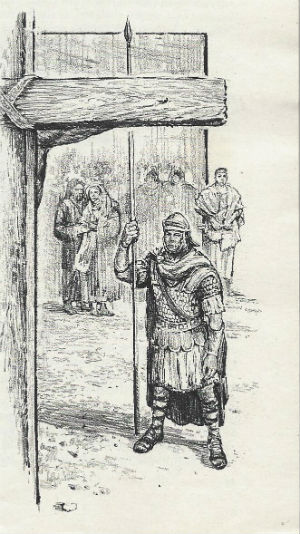 The power inherent in Christ's blood – his death upon the cross – is very great.
The power inherent in Christ's blood – his death upon the cross – is very great.By Neil Earle
 The power inherent in Christ's blood – his death upon the cross – is very great.
The power inherent in Christ's blood – his death upon the cross – is very great.It is said that not long ago Baptist candidates for hire would sometimes be asked – usually by the most elderly elder on the Search Committee – “Yes, but does he preach the Blood?”
Antique as that may sound to our post-modern ears, that is not a bad question for the church and its pastors to be asking itself from time to time.
We have now reached the point in our survey of Hebrews where the author drills down on the essential spiritual difference between the Old Covenant and the New. He shows in passages that seem difficultly translated in our English texts how God is looking for internal heart responses not cold and mechanical outward observances.
Matthew Henry’s Bible Commentary lays it out in dignified and sometimes piercing prose. Let’s read it with a few of my amendments:
“Jesus being priest, altar and sacrifice could not help but be the propitiation (atoning sacrifice) for our sins. By his own blood (symbolically) he entered the holy place envisioned for us in heaven and made eternal redemption for our sins (Hebrews 9:12).
Now consider the power inherent in Christ’s blood, by which we mean his death upon the cross.
It is very great.
It reaches to the very soul and conscience. The defiled soul produces dead works tending to death eternal.
As the touching of a dead body gave a legal uncleanness in the Old Testament, so meddling with sin gives a moral and real defilement, fixed in the very soul and spirit.
But the blood of Christ works to purge it out.
 Moses reflects God's glory: The old covenant was glorious but could not cleanse the inner conscience.
Moses reflects God's glory: The old covenant was glorious but could not cleanse the inner conscience.Jesus’ blood accepted by us in baptism activates the gracious influences of the Spirit, purchased by Christ for this purpose, that we may be enabled to serve the Living God in a new manner.
God had earlier accepted the blood of bulls and goats as typifying the blood of Christ and by these means the covenant of grace was ratified under the former dispensation.
Moses had set forth 1) water, 2) scarlet wool to bind the hyssop sprigs for the sprinkling of blood, 3) hyssop with the water signifying for us baptism; the blood, the Lord’s Supper.”
This is in Hebrews 9:19, the scarlet wool signifying our acceptance of his blood in faith, the hyssop its application to our Christian walk as attested to by David in Psalm 51, “Purge me with hyssop and I shall be clean” (Psalm 51:7).
The symbols are very special, precious and meaningful and we admire them for their profound and simple dignity for it is the cleansing of our inward parts that God is showing us here.
But it was not the ceremony that saved us but the power of the Spirit that lay behind them, hence it says Jesus offered himself by the eternal Spirit. “From frequent repetition of the sacrifices,” adds the commentator, “we see the imperfection of the Law, but now we see Jesus wounded for our transgressions, having had laid on him the iniquity of us all.” The Lamb of God who takes away the sins of the world! How wonderful all of this is beneath the cover of a solemn ritual. But once the ritual is fulfilled we have real access to real cleansing, real redress of our sinful natures and real covering for the rest of our Christian.
Well may Judson Cornwall say: “When God is in the midst of a people it will be a loving people who have warmth, spiritual insight and holy lives.”
And that interior transformation can truly change the world as it has once already.